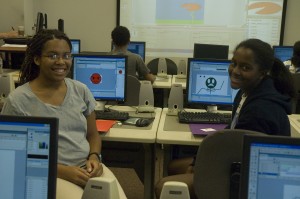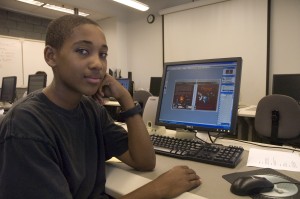Many parents think their children spend too much time playing video games, but a few have decided to help their offspring gain something constructive from their pastime. Students from local elementary and high schools enrolled this summer in the College of Extended and International Education’s (CEIE) Video Game Art and Design, Cartoons in Motion, and Advanced Video Game Design summer camps, and as a result, many of them have decided to pursue a career in designing video games.

Devin Aikens will enter the 10th grade at Fernando Pullum Performing Arts High School, Los Angeles this fall. He says that his mother enrolled him the in the four-day Video Game Art and Design program last month to get him to do something besides spending entire days playing with games on his Xbox.
“She [said], ‘Since you like video games, I’m going to enroll you in this camp,’” says Aikens. “I read the rubric on drawing cartoons and making video games and said, ‘That sounds like a lot of fun.’”
All of the students may have had extensive video game playing experience, but none had any previous design experience. And although they were challenged by the accelerated pace of the course and the intricacies of learning Flash animation, they all said they picked up the needed skills quickly.
Alicia Tran, an eighth grader at Bert M. Lynn Middle School in Torrance, is a fan of highly artistic game graphics such as Metroid Prime and Assassins Creed. She says the experience “gave me a better sense of what kind of art, scenes and catch phrases are needed in the video game world. Also, it takes a lot of hard work and dedication to finish [a project].”
Instructor Robert Dillworth is a graphic artist whose main clients are in the entertainment industry who employ his talents for production graphics, CD covers, and movie posters. He also teaches throughout the country for WE Education, which CEIE contracted to present the summer video game programs at CSU Dominguez Hills.
Dillworth says that although he loves to teach design to students of all ages, teaching the youth has its unique rewards, especially as they are more acclimated to working on computers.
“And they’re far more creative–and more disturbed –than most adults,” he laughs.
Dillworth says that at least three or four out of the dozen students in his class “have real potential.” Although he did not have access to this kind of design training as a young person, he says that when he began his own training he “fell in love with the process” and decided he also wanted to teach graphic design himself.
“I wanted to evangelize,” he recalls. “I wanted to make everyone aware of how wonderful [design] is. [WE Education] gave me the opportunity to share the knowledge with adults and children, so I jumped on it.”
Students who completed the Video Game Art and Design class in June came away with a finished animation short on disc and a Photoshop file of a video game box cover. Those who chose to take the advanced four-day course, which ends today (August 5), will have completed an actual video game, burned onto a CD, with a cover and label of their own design.

Many of the students will also walk out of video game summer camp with a career goal. Josh Payne, who is going into the eighth grade at Viewpark Preparatory Middle School in Los Angeles, always wondered how his favorite games were created. He says that he did not think that the programs used for creating video games would be so complicated, but that he was able to manipulate them easily after four days and that the best way to deal with the challenge of learning new software was “to have an open mind and open imagination and listen” to Dillworth’s instruction. But his long term goals go beyond being simply an avid player of video games.
“When I grow up I want to make video games that kids like me will enjoy,” Payne says.
For more information on programs at CEIE, click here.